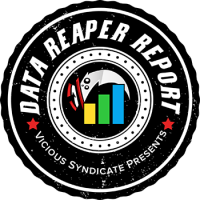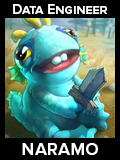
Welcome to the 142nd edition of the Data Reaper Report!
A Wild Report is coming this Sunday!
Our Data Reaper Project, including the Data Reaper Live has 4,000 active contributors and we thank them wholeheartedly. Contributing to the Data Reaper project through Track-o-Bot or Hearthstone Deck Tracker (recommended) allows us to perform our analyses and to issue the weekly reports. Without the community’s contribution, there would be no project. Contributing data is very easy and takes a few simple steps, after which no other action is required. If you enjoy our content and would like to make sure it remains consistent and free- Sign Up!
Quick Links
Class/Archetype Distribution | Class Frequency | Matchup Winrates | vS Power Rankings | vS Meta Score | Class Analysis & Decklists | Meta Breaker of the Week | How to Contribute | Credits
Number of Games
| Overall | 30,000 |
| Legend | 5,000 |
| Ranks 1-4 | 11,000 |
| Ranks 5-9 | 11,000 |
| Ranks 10-14 | 2,000 |
Class/Archetype Distribution
[TABS_PRO id=26346]
Class Frequency
[TABS_PRO id=26347]
Class Frequency Discussion
While the Shaman population has stabilized, there are signs of an internal shift within the class. Quest Shaman is declining in its play rate, while the aggressive archetypes (Murloc, Aggro) are rising in play. Aggro Shaman’s presence is particularly noticeable at legend, where a new variant has emerged (Jambre’s Mutate build, which we will talk about later).
Interestingly, Priest’s popularity has declined at legend, as well as on the climb to legend. Combo Priest has been constantly rising in recent weeks, so to see its play rate plateau and trend down is interesting.
Hunter is declining at all levels of play, and homogenizing. Highlander Hunter is trending up, while the “lesser” archetypes of the class are fading away.
Warrior’s internal shift also continues. Aggro Warrior, which we’ve labeled as last week’s Meta Breaker, is rising in popularity. Control Warrior is in decline after its recent nerfs. Be wary of the mulligan phase when queuing into Warriors: they’re slightly more likely to be Aggro if you’re at rank 4 or above, and they’re increasingly likely to be Aggro at legend.
Within the Aggro Warrior archetype, we’re noticing more Highlander variants: it’s still risky to separate their recognition without artificially inflating Highlander Warrior’s win rate. It’s something we test on a weekly basis, though even if we did separate Highlander, its current play rate would be too low for us to confidently estimate its Tier standing anyway.
Druid looks frozen in time. Quest Druid isn’t even moving an inch and remains one of the most popular decks in the format. Outside of Quest Druid though, not much else is seen within the class.
Paladin’s popularity is declining throughout most of ladder, with the exception of legend, where we can notice an increase in Holy-Wrath Paladins. Murloc, Quest and Highlander Paladin are the three other most noticeable ladder decks.
On the surface, Rogue has stayed put. Within Aggro Rogue, we can see a small uptick in a non-Pirate variant, which we’ll talk about in the Rogue section.
Warlock is declining, which isn’t a big surprise considering that Zoo hasn’t been particularly impressive lately. However, much like most other classes this week, the biggest changes in Warlock are not visible in a simple frequency chart. Zoo is undergoing an internal transition in its builds.
Mage stays at the bottom, but its popularity has risen this week. Last week, we’ve seen Highlander Mage climb in its win rate, and the big question is whether this trend has continued for this week, putting Highlander Mage in a more competitive spot.
[TABS_PRO id=26348]

[TABS_PRO id=26349]
vS Meta Score
[TABS_PRO id=26350]
vS Power Rankings Discussion
While Combo Priest can still be considered the strongest deck at higher levels of play when taking its Meta Score (Popularity and Win Rate) into account, it’s encouraging to see its win rate declining. The meta is actually beginning to effectively respond to Combo Priest and we’re starting to see players become more focused on beating it with their deck and card choices.
One of the biggest factors that keeps Combo Priest strong is the popularity of Quest Shaman and Quest Druid. The perception of power surrounding these decks has allowed Combo Priest to compete in a very favorable way. But once players attempt to play new things that contest Priest better (such as playing Aggro Shaman over Quest Shaman), the deck doesn’t look as invincible.
With Combo Priest taking a hit, Highlander Hunter looks like the best choice for the climb to legend. It doesn’t attract as much attention as Priest while boasting a very well-rounded matchup spread with few weaknesses. It’s just a very reliable deck for ladder.
Control Warrior is slightly recovering in its win rate as it declines in popularity, which is caused by the rise of aggressive decks that look to challenge Priest’s early game board control. As the meta transitions to beat Priest, it becomes more vulnerable to Control Warrior. Not many decks do well against both Priest and Warrior because the tools required to beat one deck are usually weak against the other. Highlander Hunter is the outstanding exception.
Aggro Warrior looks very powerful at higher levels of play because Control Warrior, its only bad matchup, is less common. It’s also one of the most effective decks at answering Priests, while maintaining impressive matchups against the rest of the field.
Aggro Rogue and Murloc Shaman similarly challenge Priest’s early game quite effectively, while being vulnerable to Control Warrior, keeping them very competitive and quite successful. The reason they’re inferior to Aggro Warrior is that they match up poorly against it, and have other popular matchups they don’t enjoy running into (Rogue hates queuing into Druids, while Murloc Shaman struggles against Hunters).
Zoo Warlock is looking stronger this week. It is benefitting from the transition within the Warrior class (Aggro Warrior is still a hard matchup, but it’s much better than Control) and the decline of Quest Shamans. It is also benefitting from an internal refinement process: While many players stick by the Vulture/Trasher builds, the Lackey/Tekahn builds outperform them on ladder and their increase in play is positively contributing to the archetype’s overall win rate.
As other decks improve, Murloc Paladin is growing weaker. Its build has long been figured out and its scope for improvement is extremely limited. It’s a fine ladder deck, but certainly not a dominant one.
Highlander Mage is getting closer and closer to the 50% mark, suggesting that it’s strong enough to be competitive on ladder. The improvement in its win rate mostly comes down to players figuring out how to build it after the patch. Its matchup spread is very flat: it’s one of the least polarizing decks in the game, with a fair chance of winning any matchup. What drags its win rate down is its Highlander Hunter matchup, which is very poor and stains an otherwise clean deck.
Class Analysis & Decklists
Druid | Hunter | Mage | Paladin | Priest | Rogue | Shaman | Warlock | Warrior
Shaman has had quite a bit of development this week. It seems that the aggressive archetypes of the class are getting more attention, stepping out of Quest Shaman’s shadow and proving to be superior against the field.
Jambre hit #1 legend with a token variant of Aggro Overload Shaman that includes Sea Giants and Former Champ. The Mutate/Fleshshaper package looks strong in basically every archetype of the class, with Murloc Shaman recently benefitting from its inclusion as well.
This deck’s ability to flood the board and cheat out big threats makes it a formidable foe for Quest Druid, which normally handles burn-centric variants much better thanks to Hidden Oasis. Its early game board control also gives it a decent edge into Quest Shamans.
But most importantly, the Likkim/Overload package allows us to contest Priest’s early game very consistently, which is a recipe for success in the matchup. With Aggro Shaman looking strong against the three most popular decks in the format, it cannot be ignored. It’s a potential meta breaker.
While some players are beginning to refine new decks that look to target Combo Priest, the process is still very slow. Most players continue to play decks that easily fall prey to the dominant deck, which keeps the dominant deck – ahem, dominant.
And if the meta isn’t changing quickly enough, Combo Priest certainly shouldn’t change either. It’s an early game powerhouse that is only countered by decks that have dedicated cheap removal to push it off the board and disrupt its game plan. It has a combo finisher that is made consistent by an extremely powerful and synergistic draw engine. It has arguably the strongest mid-game plays thanks to Amet and Psychopomp.
Combo Priest is winning, and as long as players continue to pass their turn 1’s and let a 1 mana 1/3 take over the game uncontested, it will continue to win.
As enthusiasm for Control Warrior is declining, Aggro Warrior is getting more attention. Its ability to challenge the top meta decks while carrying only one bad matchup is proving to be valuable.
While Aggro Warrior is doing well, Highlander Aggro Warrior builds are beginning to emerge once again after the top legend success of multiple players. This variant still has a low play rate (estimated to be around 1%) and circulates within a narrow population of more dedicated players, which means it is difficult to objectively compare with normal Aggro Warrior without risking “source bias” – the phenomenon of a deck having an inflated win rate as a result of its origin and its initial spread amongst a specific population of players. As we’ve said earlier, there is also the issue of recognizing Highlander Warrior separately from Aggro Warrior.
Even so, we’ve looked into the variant and tweaked the most common builds into a list that is likely to be the strongest one. The main takeaways: (1) Injured Blademaster and Neferset Ritualist are weak, and don’t have the standalone strength of Injured Tol’vir, which is just a good play on-curve; (2) Upgrade! is a weak card in both standard and Highlander builds of Aggro Warrior; (3) we’re a bit surprised at the absence of Militia Commander and Redband Wasp from this variant. They should clearly be included.
Highlander Hunter is one of the best ladder decks in the game thanks to a balanced matchup spread that carries nearly no unfavored matchups against common meta decks. It’s just a really good choice at all levels of play if you’re interested in a deck that has game against any opponent.
Quest Hunter would have broken out if not for its terrible Priest matchup. Its relative success on ladder suggests that the quest has great potential to produce a top meta deck in the future.
Mech and Midrange Hunter are also around, but both decks are flawed to a point where they’re unlikely to see more play. Mech Hunter struggles against Shamans and Warriors, especially aggressive variants of these classes. Midrange Hunter’s slow and grindy playstyle makes it a sitting duck for Druids that simply outpace it once the quest has come online, and it also struggles to beat Highlander Hunter in the mirror.
Quest Druid is pretty strong. It has a very defined weakness that some decks can take advantage of (snowballing early board decks: Priest, Zoo, Murlocs), but its power spike in the mid-game is so dramatic that opponents that fail to pressure it quickly will struggle to close out the game in their favor.
Much is talked about nerfing Priest, and the biggest winner of such a change would certainly be Druid. Its performance against the other top meta decks (Warrior, Shaman, Hunter) is very impressive. It’s also why Quest Druid is usually the best performing deck in tournament line ups that ban Priest.
Many players consider Quest Druid to be a “midrange” deck, but it behaves very much like a late game strategy. Its “late game” just happens to start on turn 5-6. We think there’s a stylistic similarilty between Quest Druid and the old Crystal Core Quest Rogue. Old Quest Rogue was a more polarizing and extreme deck than Quest Druid, but they shares a few common traits.
One thing we’re certain of is that Druid’s SoU set will be the foundation of any late game strategy within the class until it rotates (much like the class’ KFT set), and it can be considered one of the strongest class sets ever.
Paladin is stagnating, and it’s become clear that its presence at higher levels of play will continue to be fairly niche.
Murloc Paladin is a strong deck for ladder, especially at lower ranks. But once you reach higher ranks and face better players, its performance against Warrior and Shaman becomes a significant limitation.
Holy-Wrath Paladin is playable, and has reasonable matchups against some of the most popular meta decks, but its overall matchup spread on ladder still isn’t great.
Highlander Paladin is okay, but its weakness vs. Priests and Shamans means it’s unlikely to be consistently successful because the meta is largely dictated by these classes.
Quest Paladin is a pretty terrible choice for ladder, as it is completely hopeless against Priests and Shamans. Control Warrior is nowhere near popular enough to justify it. Don’t queue it up if you’re looking for a serious ladder climb.
Rogue has found an important role in the current meta, as it’s one of the classes best equipped to beat Priests thanks to its strong early game removal and tempo swings.
ZachO hit top 100 legend with a Rogue deck that’s different from the standard Aggro Rogue build you mostly see on ladder. Instead of the Pirate/Burn package, he included the Vendetta/Burgle package as well as Heistbaron Togwaggle alongside Cable Rats and Jar Dealers. This list has a very similar matchup spread to Aggro Rogue, but it’s less polarizing. It performs better at Rogue’s traditionally worst matchups (Warrior, Druid) while sacrificing percentages against its better matchups (Shaman, Hunter). It packs more value, helping it last longer into the late game, but it is slower at killing opponents as a result.
Warlock is a niche class that doesn’t have too many strong selling points. Zoo Warlock is good against Druids, but not much else within the top meta decks. Shamans and Warriors (Aggro or Control) are sore spots that take the wind out of the deck’s sails, and are a big reason why the deck isn’t very popular in tournaments either. However, Zoo is certainly not a bad deck, and if you’re not running into an overbearing number of Warriors on ladder, you have a good chance of doing well with it.
Highlander Mage’s win rate has increased further and is closing in on the 50% mark. That’s pretty good news, indicating that the class isn’t as deep in the dumpster as it initially looked post-patch. The problem is that Mage doesn’t have anything specific going for it. It does fairly well in most matchups, and most of its games on ladder are winnable, but its struggles against Highlander Hunter push its win rate towards the negative side.
One easy tip we can provide you: Play Polymorph. It’s quite good in many matchups, but it makes a massive difference against Priests.
We normally don’t highlight decks in the Meta Breaker section that have yet to exhibit a large enough sample for us to include in the Power Rankings. However, there is an exception when it comes to decks that are so clearly good even when taking into account the variance that a low sample brings to the table.
Jambre’s Aggro Shaman could break or bend the Hearthstone meta in a very meaningful way. It’s a deck that displays potential of lining up positively against the popular axis of Combo Priest, Quest Shaman and Quest Druid, and its Warrior matchup is not as bad as what we’ve seen from previous Aggro Shaman builds.
Whether it’s Tier 2 or Tier 1, it’s a deck that clearly belongs in the meta and merits more play and exploration, both on ladder and in tournaments. Just how good is it? We may find out in the next couple of weeks.
Jambre’s Overload Mutate Shaman
Our Data Reaper Project, including the Data Reaper Live has 4,000 active contributors. Without them, this project would not be possible, so we’d like to thank all of our contributors for their help.
Preparing our weekly article requires a significant amount of time and effort from many individuals. We would like to wholeheartedly thank our current Patreons, whose generous donations help us fund computing and server costs.
vS Gold is a new membership plan aimed to support our efforts towards improving our content and data analysis while receiving some bonuses and extra features.
Tier 3+ Patrons
Special thanks to Leo G, Aaron B, Jed M, Drew M, Alan J, Eric L, Zolstar, Sean H, Steve F, Andrew N, NObdy, Mark S, Alonso P, msKang, James Y, PinkMageDiaries, Je-ho, Ziqiao Y, Stephen H, and William H for supporting us for the month of September.
Contributors
Here are all the people that participated in bringing you this edition of the vS Data Reaper Report:





























